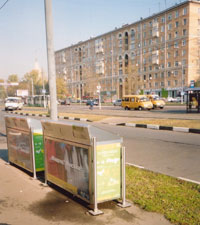Annual Report 2010-2011
The USSR and its contribution to global environmental scientific understanding and policy prescription, 1945-1991
ESRC award reference number: RES-062-23-1734
Jon Oldfield, University of Glasgow, UK
Denis Shaw, University of Birmingham, UK
Brief overview of activities
This project aims to explore the nature and character of Russian/Soviet conceptualisations of society-nature interaction and their contribution to  global environmental scientific understanding during the period 1945-1991 with particular reference to input from geographical and cognate environmental sciences.
global environmental scientific understanding during the period 1945-1991 with particular reference to input from geographical and cognate environmental sciences.
A total of 6 research questions are outlined in the original proposal. During Year 1 of the project, attention was directed to research questions 1, 3 and to a lesser extent, 6:
- (1)What key debates concerning society-nature interrelations took place in Soviet geographical and cognate environmental sciences during the period 1945-1991, and how far were such debates a sequel to those of an earlier period?
- (3)What was the significance of individual scientists such as A.A. Grigor’ev [1883-1968], I.P. Gerasimov [1905-1985], L.S. Berg [1876-1950], and V.N. Sukachev [1880-1967] for the development of the Soviet understanding of nature-society interaction?
- (6)In what ways, and to what extent, were Soviet geographers and environmental scientists influenced in their ideas by contemporaneous international discussions and conceptions concerning the global environment and what was the nature of their intellectual and practical contributions to international scientific endeavour?
(i)In order to initiate a reflection on the key debates concerning nature-society interrelations in Soviet geographical and cognate environmental sciences post-1945, the following journals were reviewed:
- Izvestiya akademii nauk SSSR: Seriya geograficheskaya
- Izvestiya vsesoyuznogo geograficheskogo obshchestva
- Vestnik akademii nauk
- Voprosy geografii
- Soviet Geography: Review and Translation
In addition, a range of Russian language monographs and edited collections were accessed via the holdings of the British Library (London), Oxford University, National Library of Finland (Helsinki), and the National Library of Russia (St Petersburg). Library work also included extensive bibliographical work. In addition, the Slavonic collections of the University of Glasgow and University of Birmingham were also accessed.
(ii)An evaluation of the work of individual natural scientists was initiated via a critique of their original publications and biographical works. In particular, specific attention was paid to the following: A.A. Grigor’ev [1883-1968, geographer], I.P. Gerasimov [1905-1985, geographer], L.S. Berg [1876-1950, geographer and a main proponent of Landscape Science], V.A. Kovda [1904-1991, soil scientist].
(iii)Work was also carried out with respect to Soviet engagement with the 1968 UNESCO-sponsored Biosphere Conference and related understandings of the biosphere concept. The resulting paper is entitled: ‘V.I. Vernadskii and the development of biogeochemical understandings of the biosphere, circa 1880s-1968.’ At a general level, the paper helps to open up debate surrounding the nature of the links between Russian/Soviet understanding of the global environment and analogous conceptual developments in the international community. More specifically, drawing from the sociology/geography of science literatures, the paper identifies four key moments which, it is argued, help to explain the development and subsequent dissemination of a biogeochemical understanding of the biosphere. First, we draw attention to the particularities of St. Petersburg’s natural science community during the late nineteenth century, arguing that this was instrumental in providing the basis for Vernadskii’s future work related to the biosphere. Second, we consider the way in which Vernadskii’s ideas concerning the biosphere were able to move to the West during the first half of the twentieth century with specific reference to his links with the French scientists, Teilhard de Chardin and Edouard Le Roy, and the US-based ecologist, George Evelyn Hutchinson. Third, we reflect more purposefully on matters of reception and, in particular, the emergence of a set of circumstances within Western ecological science post-1945, which encouraged a positive engagement with biogeochemical understandings of the biosphere. Finally, we examine the 1968 UNESCO-sponsored Biosphere Conference, which represented the first time the biosphere concept was employed at the international level. Furthermore, this event was in many ways a high-point for a specifically biogeochemical approach with the subsequent popularisation of the biosphere concept during the course of the 1970s helping to broaden the discourse markedly.
Writing activities
Finished papers:
- Oldfield, J and Shaw, DJB, V.I. Vernadskii and the development of biogeochemical understandings of the biosphere, circa 1880s-1968
Papers in preparation:
- Paper exploring the academic discussions surrounding the Great Stalin Plan for the Transformation of Nature with a specific focus on the contemporary discussions of Soviet geographers as well as the links between the plan and the earlier work of V.V. Dokuchaev.
- Paper exploring the early debates within Soviet geography and related disciplinary fields concerning climate change.
Book:
- Oldfield, J and Shaw, DJB, provisional title: Russian Environmental Thought, 1880-1991, contract with Routledge, provisional publication date 2012/13.
The work on this book is also underpinned by work being carried out on the AHRC-funded project: ‘The Landscape Concept in Russian Scientific Thought, c1880s – 1991.’

